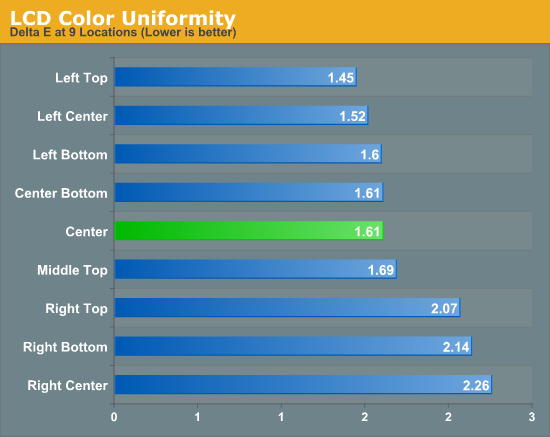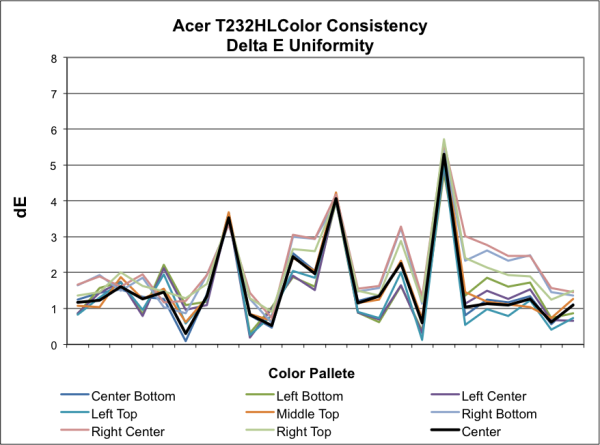Acer T232HL - Touch Comes to the Desktop
by Chris Heinonen on February 6, 2013 9:00 AM ESTDisplay Uniformity
For some reason, display uniformity is where I see a big issue with the Acer T232HL. Using a 5x5 ANSI grid, there is a clear drop in light output on the right side of the screen. While the center is at 200 nits, this whole column of values is below 180 nits, for at least a 10% reduction in light output.
| Top | ||||||
| Left | 218.2 | 215.4 | 197.2 | 172.3 | 188.1 | Right |
| 206.1 | 206.4 | 192.9 | 179.9 | 188.9 | ||
| 213.2 | 207.3 | 199.7 | 179.0 | 179.5 | ||
| 207.5 | 206.1 | 193.4 | 180.8 | 187.9 | ||
| 217.9 | 209.8 | 187.5 | 167.9 | 193.5 | ||
| Bottom | ||||||
Additionally the left side of the screen is really bright, leading to variations across the screen of up to 50.3 nits. This is a huge difference and one that is easily noticeable by average users. I really haven’t seen anything come close to this before, as usually the smaller differences in screen brightness are something I can accept. Looking strictly at the average values the screen looks good, but with the raw values and the surface chart you can see that something is clearly wrong here.
Looking at the black uniformity this issue is still there. It’s not as easy to see because of the lower numbers, but you can see it drop in the same area as before. The incredibly bright spot at the bottom is a bit strange, but I did the reading multiple times to verify that it was correct. All of the corners except for the upper-right have a good bit of light bleed in them as well.
Because both black and white levels have issues in the same part of the screen, contrast uniformity is actually pretty good on the Acer! That’s a bit of damning with faint praise, but since the contrast ratios are very good, it is a bit of a bright side. There is a big drop in the center-bottom reading, but overall the contrast stays pretty close to the 1000:1 level that we measured earlier.
As expected, the weird uniformity issues are here to mess with the color uniformity as well. The average dE for the screen is 1.77 relative to the 1.61 for the center, but the average for the right side is 2.16, a good amount above the center figure. The largest issue seems to be in the grayscale, as the right side produces the three worst results for the grayscale on the whole. All of the values stay at or below 3.0, but it is still much worse on that side than on the center or left side of the display.

Unfortunately, the Acer has a serious issue with panel uniformity, one that could be the result of a number of things. In the end, it is a serious flaw on the display and one that I haven’t seen be so bad in the past.















66 Comments
View All Comments
zero2dash - Wednesday, February 6, 2013 - link
Horrible decision.That thing will be filthy in hours.
Flunk - Wednesday, February 6, 2013 - link
You can't have a touchscreen with a matte finish, the two features have to go together. If you don't like it you can always get a matte non-touchscreen there are lots of those on the market.JanieMartin - Thursday, February 7, 2013 - link
Love my job, since I've been bringing in $5600… I sit at home, music playing while I work in front of my new iMac that I got now that I'm making it online.(Click Home information)http://goo.gl/q9r5k
Beaver M. - Thursday, February 7, 2013 - link
Funny, I have one of those right here. Works fine. Given it is also transflexive, but it is matte.Beaver M. - Thursday, February 7, 2013 - link
Transflective of course.shtldr - Thursday, February 7, 2013 - link
I've seen a matte touch desktop display about 7 years ago. It was probably the resistive type as one had to use some force.Not sure if they're still being produced with all this tablet/smartphone glass capacitive fad of late, but they can be had.
Tams80 - Friday, February 8, 2013 - link
Absolute rubbish! I'm using a Tablet PC with a matte touchscreen right now.roberto.tomas - Tuesday, February 19, 2013 - link
Is that true for proj. capacitive as well as optical? 2-point multitouch systems should probably need glossy, because they are optical. But 10-point is usually more expensive projective capacitive (and I didn't know if they needed matted too).My take on the monitor: horrible, disturbingly bad color gamut for a monitor that is glossy. The sRGB % for this thing is as low as a $60 commodity 11.6" laptop matte from AUO. But; full 10-point multitouch in the sub-$1 grand range, good range of pivot, and not entirely small 23". I'm lukewarm to the thing, if it went onf half off sale I might pick one up ... maybe.
Homeles - Wednesday, February 6, 2013 - link
Read the article, genius:"I worried a lot about fingerprints and smudges with the glossy finish, but I didn’t find myself having to clean it that often, and typically they were hidden away well."
zero2dash - Wednesday, February 6, 2013 - link
When you grow up, have sex, and have kids, you'll realize that glossy screens get fingerprints all over them.Maybe this monitor works for 1 person who cleans their hands every five minutes.
In a normal household with more than 1 person and normal use, the thing would be filthy in no more than 24 hours. I have fingerprints on all my monitors, flat screens, and every other glossy screen device in our house...and half of those devices aren't even touch screens.